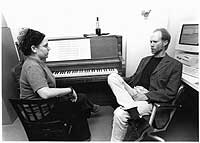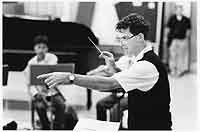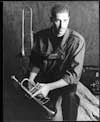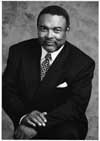Sound and
Sensibility:
Composers, Conductors, and Collaboration
by Marci Janas
 |
| Composers John Luther Adams and junior Kate Peterson discuss one of her works-in-progress for a New Music Workshop class. Photograph by John Seyfried. |
THE CREATION
AT A PIANO OR IN A PARK, the composer is at work. Sitting in a studio or standing on the verge of a raging sea, the composer listens. Like the writer humbled before the whiteness of the page, the composer waits for what must make itself known as music.
Consider for a moment the problem. What the composer has heard as music, once neatly scored and notated, is handed off to some significant other. Here, this is what I've given birth to. And whether it's blues, jazz or music so new it defies a genre, it will be up to the conductor - or an intrepid ensemble of musicians - to invigorate and re-create this life's work.
That's a lot of pressure to put on a relationship.
While composer John Luther Adams, associate professor of composition, describes the initial work on a new piece as "solitary and contemplative," he says the completed score doesn't signal the end of the labor. "I rely on the talent, skill, creativity and generosity of performing musicians to bring the sounding music into the air. And the circle isn't finally closed until the music is received by attentive listeners, with open ears."
Adams' contemplative music is inspired by Arctic landscapes and extreme climates, a geography that he has called "the region between place and culture, between environment and imagination." For him that region is Alaska, where he has lived and worked for most of his creative life. But it is unlikely that most of the conductors and musicians who re-create his work, well traveled though they might be in the developmental journeys of musical motifs, have experienced such intense Northern exposure. For them, Adams' work must present a unique challenge.
Asked whether a definitive performance of his music is possible, Adams says "I hope not. I want to believe that the music contains enough substance within it to support many 'definitive' performances."
 |
| Timothy Weiss, associate professor of wind conducting." Photograph by John Seyfried. |
THE COLLABORATION
TIMOTHY WEISS, associate professor of wind conducting, has frequently conducted Adams' work, as well as the work of many living composers. When he has the rare luxury of a composer's presence during rehearsal, the best dynamic occurs, he says, when decisions on interpretation, pacing and style become collaborative. This is particularly true when a work is so new that it has never been recorded; where "the wheel hasn't been invented and there's a built-in sort of education to draw from," he says.
Last year Weiss conducted the Oberlin Contemporary Music Ensemble (CME) in Adams' In the White Silence, a piece he characterizes as "very new, very unique. I'd never done anything like that before." And while he says that sometimes new music can be extremely complex, with layers of notations and intricacies of detail, Adams' work "is not hard to understand--what is written on the score is quite apparent."
Still, with this particular piece, " It would have been very difficult to figure out exactly what direction I should take without him there." The rewards of working closely with Adams--he was present at all but two or three of twelve rehearsals--gave the process a very authentic feeling, says Weiss. "There was never any guessing."
Is there a downside to so much togetherness? Weiss says that Adams "understands the process of preparing and rehearsing. He'd have input, but he did it in such a way that it didn't waste time." This hasn't always been Weiss' experience. "Time and money are at a premium when you are rehearsing. Sometimes the rehearsal process can become bogged down a little bit, with a composer causing the process to go slower than necessary."
THE
PERFORMANCE
"Paradoxically," says Adams, "It's conductors who add the least by way of 'interpretation' who most powerfully shape a new piece of music."
Weiss adds, "Performers and conductors have a tremendous impact on the way a performance is done. And if not, then why do it? If we didn't we would simply be artisans, and not artists."
Weiss considers himself a performer, again, a nod to the collaborative aspect of these huge endeavors. "In some scores," he says, "There's so much instruction or information through the notation that you wonder how much you're affecting the piece. Ultimately the score does not make any noise; it's only a set of instructions for how to make the sound. The pacing of the piece, its balance, the way articulations are made and the way phrases are pulled and released ultimately are up to the discretion of the performer."
Adams calls himself "a recovering perfectionist," wanting the work to be as perfect as possible. But over the years he's come to understand that "wholeness is better than perfection."
place, offering a lot of backseat driving advice. But the more experience I gain, and the more I have the opportunity to work with outstanding conductors and instrumentalists, the more I try to stay out of the way and let the musicians do their work."
Student composer kate peterson, who prefers the lowercase spelling, had, at the time she was interviewed for this article, been Adams' student "for a little under 12 hours." She says Adams is the first person to ever really critique and evaluate her work outside of a classroom setting.
Hearing her music live "is possibly the most critical part of my compositional process, because I can evaluate whether or not what I was trying to accomplish was successful." She tries to get every piece she's written performed. For her, perfection--unlike Adams' quest for wholeness--has been hearing "how I would exactly perform the piece. Last year I felt it was very important for me to begin to let go of some of that control, realizing that I would not be able to stand over every performer who would ever play my pieces."
This sort of thing is not uncommon. Weiss recalls past collaborations with professor of composition and music theory Randy Coleman, who, he says, likes to compose performer freedom into a work. "Coleman would argue that music in this century has become so over-notated that a lot of performance freedom has been lost. His reaction is to mandate it by forcing people to make decisions"--indicating, for example, that improvisation must occur in a particular section.
Adams, when asked if his work allows for any improvisation or freedom of interpretation, replies: "Improvisation is a demanding discipline. My work is concerned with a different, more formalist kind of discipline."
Peterson says that although she writes in several different veins, she doubts that her music has ever truly needed a conductor, though it has required "a clock, sometimes." Lately, more of her work is "performer oriented--written with some guidelines but lending itself to improvisation. I like the art of improvisation because I am not trained in jazz at all, and jazz is really one of the only mainstream improvisational strains of music."
Indeed. So where does this leave the composer/conductor relationship in jazz? Or the blues?
 |
|
Michael
Mossman '82,
|
THE ARRANGEMENT
WHAT JAZZ WANTS TO BE IS OFTEN determined by which arrangement among many might be played at any given moment by any given ensemble.
Michael Philip Mossman '82, director of jazz studies at the Aaron Copland School of Music at Queens College, talks of the "blurry, gray line" between original compositions and commissions of arrangements. His music-writing life is fairly divided between the two.
"When you get into arranging, a lot of times what you're really dealing with is composing. Arranging is a transformation . . . where you rediscover the tune altogether. Often, we begin with the tune and completely change the intent. This gets into more of a compositional kind of treatment, rather than just an orchestral treatment."
Mossman continues, "The problem with jazz is if you play the same arrangements over and over again, you can preserve the sound but not the intent, which is transformational. Jazz music was never meant to be static, or totally archival. In jazz, we count on the piece being transformed every time it's performed."
As a composer, Mossman says that "most of the time" other performers have achieved the essence of what he's created, "but the most pleasant of these times are when I'm surprised. Once I hear that the written part is performed well and accurately, then the next thing I'm looking for is the surprise: what the musicians add."
That said, Mossman does believe that an essential quality runs through his work. When asked to define it, though, he can't get away from jazz's communal nature. Nor does he try. Influence and inspiration --tradition -- inform the sensibility of jazz. "In working with players such as Dizzy Gillespie and Horace Silver and Mario Bauza, I learned some things about intent," he says. "These are three people whose writing I respect a great deal, whose sense of music I respect. I also have to credit my former teacher Wendell Logan. He's so much a part of who I am as a composer. He taught me that if you're going to write music, there's a deep tradition of writing notes that have something to say . . . a tradition of composition requiring thought and craft. Counterpoint, for example, the development and transformation of ideas, the inclusion of ideas from the jazz tradition presented in new ways. . . ."
 |
|
Wendell
Logan
|
THE IMPROVISATION
IMPROVISATION IS A PRIMARY aspect of composer Wendell Logan's work, who calls jazz and blues "some of the most heraldic music there is. . . .The blues is a way of looking at the world and a way of reacting to the world," he says. "And the blues is about many things, but it's about making a way when there seemingly isn't a way. It's about improvising."
Logan is chair of Oberlin's jazz studies program and professor of African-American music. Asked whether, given jazz's improvisational nature, it can be conducted, he laughs and says "Not well. A good conductor--if there is such a thing in jazz--is a person who gets up there, gives a downbeat, gives the cutoff or whatever, and gets out of the way. Anybody else is out there for show."
Logan's composed works cross genres; his work is influenced not only by blues and jazz and other music from the African-American experience but also by opera and poetry. Consequently, his works have often required a conductor at the helm. Occasionally, he fills that role himself, but sometimes, he says, he favors the experience of listening over the experience of conducting. He says his main concern, once he has let go of a piece, is that the person conducting it will "have the opportunity to spend the amount of time necessary to realize his vision."
